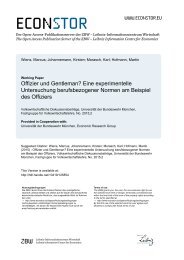DISCUSSION
n?u=RePEc:iza:izadps:dp10283&r=exp
n?u=RePEc:iza:izadps:dp10283&r=exp
Create successful ePaper yourself
Turn your PDF publications into a flip-book with our unique Google optimized e-Paper software.
3.4 Impact of task-based goals on student performance<br />
We saw in Section 3.3 that task-based goal setting successfully increased the students’ level<br />
of task completion. Table 6 provides evidence that asking students to set task-based goals<br />
also improved student performance in the course, although our effects are on the margins of<br />
statistical significance. As in Section 3.2, we consider three measures of performance: (i) credit<br />
in the course, measured by students’ total points score in the course (out of one hundred) that<br />
determines their letter grade; (ii) the probability that students achieved an A– or better; and (iii)<br />
the probability that students achieved a B+ or better. 20 The first column of Table 6 reports<br />
OLS regressions of credit on an indicator for the student having been randomly allocated to<br />
the Treatment group in the task-based goals experiment. The second column, titled ‘Median’,<br />
reports unconditional quantile regressions for the median of credit on the same indicator. 21 The<br />
third and fourth columns report OLS regressions of, respectively, an indicator for the student<br />
having achieved an A– or better and an indicator for the student having achieved a B+ or better<br />
on the same indicator as in the first two columns. To give a feel for the magnitude of the effects,<br />
the second row in each panel reports the effect size as a proportion of the standard deviation of<br />
the dependent variable in the Control group in the task-based goals experiment, while the third<br />
row reports the average of the dependent variable in the same Control group.<br />
Panel I of Table 6 shows that, across male and female students, asking students to set goals<br />
for the number of practice exams to complete improved performance by about 0.1 of a standard<br />
deviation on average across the four specifications. The median regression of credit on the<br />
treatment gives an effect that is statistically significant at the five-percent level, while the three<br />
other specifications yield effects that are significant at the ten-percent level (the tests are all<br />
two-sided). Panels II and III show that task-based goals were effective for male students but<br />
not for females. For male students task-based goals improved performance by almost 0.2 of a<br />
standard deviation on average across the four specifications. This corresponds to an increase<br />
in credit of almost two points and an increase in the probability of achieving a A– or better of<br />
almost ten percentage points. The effects of task-based goal-setting on the performance of male<br />
students are strongly statistically significant (three of the four specifications give significance at<br />
the one-percent level, while the fourth gives significance at the five-percent level). On the other<br />
hand, Panel III shows that task-based goals were ineffective in raising performance for female<br />
students. On average across the four specifications, task-based goals improved the performance<br />
of female students by only 0.02 of a standard deviation (and the effect of task-based goals on<br />
the performance of female students is statistically insignificant in all four specifications).<br />
The regressions in Table 6 control for student characteristics: the results are quantitatively<br />
similar but precision falls when we do not condition on student characteristics (see Table SWA.5<br />
in Supplementary Web Appendix I).<br />
20 B+ was the median letter grade across the four semesters of our study.<br />
21 The median results were obtained using the estimator of Firpo et al. (2009), which delivers the effect of the<br />
treatment on the unconditional median of credit.<br />
17




